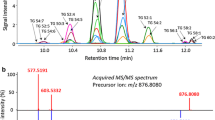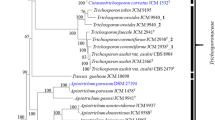Abstract
The composition of fatty acids synthesized de novo by thirty strains of zygomycetes from various taxa was studied. The qualitative fatty acid compositions of the fungal lipids were found to be virtually identical, but there were significant differences in the contents of individual acids. Highly active producers of essential C18 fatty acids, with their content exceeding 30–40% of total fatty acids, were discovered among the fungi of the families Mucoraceae, Pilobolaceae, and Radiomycetaceae. Linoleic acid was found to predominate in the fungi of the genera Radiomyces, Mycotypha, and Circinella, and linolenic acid (identified as its γ-isomer by gas-liquid chromatography), in the fungi of the genera Absidia, Circinella, Pilaira, and Hesseltinella. The total yield (mg/l) of bioactive acids (C18:3, C18:2, C18:1) varied from 761.4 in Pilaira anomala to 3477.9 in Syncephalastrum racemosum; the total yield of essential acids, from 520.7 in Pilaira anomala to 1154.5 in Hesseltinella vesiculosa; of linoleic acid, from 279.7 in Pilaira anomala to 836.3 in Mycotypha indica; and of linolenic acid, from 120.8 in Mycotypha indica to 708.0 in Hesseltinella vesiculosa. The data on the efficient synthesis of these acids make the actively producing strains promising for biotechnological synthesis of commercially valuable lipids. Linderina pennispora VKM F-1219, a zygomycete of the family Kickxellaceae, which was earlier singled out into the order Kickxellales, was shown to differ from zygomycetes of the order Mucorales in having a high content of cis-9-hexadecenoic (palmitoleic) acid, reaching 37.0% of the fatty acid total.
Similar content being viewed by others
REFERENCES
Löosel, D.M., Fungal Lipids, Ratledge, C., and Wilkinson, S.G., Eds., London: Academic, 1988, vol. 1, pp. 699–806.
Ratledge, C., Biotechnology of the Oils and Fats, Ratledge, C. and Wilkinson, S.G., Eds., London: Academic, 1989, vol. 2, pp. 567–668.
Konova, I.V., Rudakova, L.M., Pan'kina, O.I., and Orekhova, L.F., Lipogenesis in Mycelial Fungi as Related to Cultivation Conditions, Mikrobiologiya, 1987, vol. 56, no. 3, pp. 783–791.
Tarell, D., The Fatty Acid Composition of Some Entomophthoraceae, Can. J. Microb., 1967, vol. 13, pp. 755–760.
Totani, N. and Oba, K., The Filamentous Fungus Mortierella alpina, High in Arachidonic Acid, Lipids, 1987, vol. 22, pp. 1060–1062.
Sönnichen, M. and Müller, B.W., Rapid and Quantitative Method for Total Fatty Acid Analysis of Fungi and Other Biological Samples, Lipids, 1999, vol. 34, no. 12, pp. 1347–1348.
Weete, J.D. and Ganhi, S.R., Sterols and Fatty Acids of the Mortierellaceae: Taxonomic Implications, Mycologia, 1999, vol. 91, pp. 642–649.
Skulachev, V.P., New Biochemical and Therapeutic Effects of Polyunsaturated Fatty Acids: A Review of the Monograph “Medical Fatty Acids in Inflammation,” Kremer J.M., Ed., Biokhimiya, 1999, vol. 64, p. 864.
Konova, I.V. and Bekhtereva, M.N., Physiological and Biochemical Peculiarities of Lipogenesis in Mycelial Fungi and the Prospects of the Application of Fungi as Lipid Producers, Metabolizm lipidov u eukariotnykh mikroorganizmov (Lipid Metabolism in Eukaryotic Microorganisms), Pushchino: Pushchinskii nauchnyi tsentr, 1991, pp. 3–13.
Konova, I.V., The Use of Micromycetes as Producers of Lipid Preparations, Moskva i Nauka (Moscow and Science), Izd. MKNT Pravitel'stva Moskvy, 1997, vol. 27(157), pp. 68–75.
Mil'ko, A.A., Opredelitel' mukoral'nykh gribov (A Determination Manual of Mucorous Fungi), Kiev: Naukova Dumka, 1974.
Kates, M., Techniques of Lipidology, Amsterdam: Elsevier, 1972.
Funtikova, N.S., Pan'kina, O.I., Mysyakina, I.S., and Konova, I.V., Synthesis of gamma-Linolenic Acids and Carotenoids by Fungi Mucorales, Mikrobiologiya, 1998, vol. 67, no. 3, pp. 345–348.
Radwan, S.S., Zreic, M.M., and Muller, J.J., Distribution of Arachidonic Acid among Lipid Classes during Culture Ageing of Five Zygomycete Species, Mycol. Res., 1996, vol. 100, no. 1, pp. 113–116.
Meditsinskaya mikrobiologiya (Medical Microbiology), Pokrovskii, V.I. and Pozdeev, O.K., Eds., Moscow: GEOTAR, 1998, pp. 851–896.
Batrakov, S.G., Konova, I.V., Sheichenko, V.J., Esipov, S.E., and Galanina, L.A., Two Unusual Glycerophospholipids from Filamentous Fungus Absidia corymbifera, Biochim. Biophys. Acta, 2001, vol. 1531, pp. 169–177.
Tyutyunnikov, B.N., Khimiya zhirov (Chemistry of Oils and Fats), Moscow: Pishchevaya Promyshlennost', 1966.
The Lipids Handbook, Gunstone, F.D. et al., Eds., London: Chapman & Hall, 1986.
Konova, I.V., Sultanovich, Yu.A., Pan'kina, O.I., and Rudakova, L.M., Nonsaturation of Lipids as Related to the Physiological Peculiarities of the Fungus Cunninghamella japonica Growth, Prikl. Biokhim. Mikrobiol., 1986, vol. 24, no. 4, pp. 542–548.
Benny, G.L., Classical Morphology in Zygomycete Taxonomy, Can. J. Bot., 1995, vol. 73, suppl. 1, pp. S725–S730.
Author information
Authors and Affiliations
Rights and permissions
About this article
Cite this article
Konova, I.V., Galanina, L.A., Kochkina, G.A. et al. Fatty Acids in the Species of Several Zygomycete Taxa. Microbiology 71, 550–557 (2002). https://doi.org/10.1023/A:1020506702892
Issue Date:
DOI: https://doi.org/10.1023/A:1020506702892




